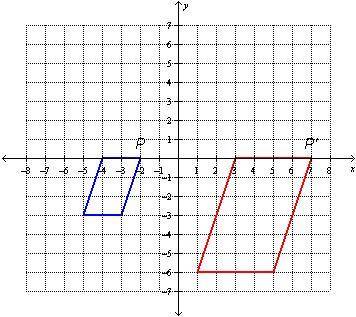
Mathematics, 08.02.2021 19:00 med69
The parallelogram on the left was dilated by a scale factor of 2 about point P. It was then transformed in another way to produce the parallelogram on the right.
On a coordinate plane, parallelogram P has points (negative 4, 0), (negative 2, 0), (negative 3, negative 3), (negative 5, negative 3). Parallelogram P prime has points (3, 0), (7, 0), (5, negative 6), (1, negative 6).
Which identifies the transformation that occurred after the dilation?
a translation of 9 units to the right
a translation of 3 units down
a reflection across the x-axis
a reflection across the y-axis


Answers: 2


Other questions on the subject: Mathematics



Mathematics, 21.06.2019 17:30, margaret1758
Use the distributive law to multiply. 3(4x + 5y + 6)
Answers: 2
You know the right answer?
The parallelogram on the left was dilated by a scale factor of 2 about point P. It was then transfor...
Questions in other subjects:


Business, 30.10.2019 06:31


Health, 30.10.2019 06:31

Mathematics, 30.10.2019 06:31

Mathematics, 30.10.2019 06:31






